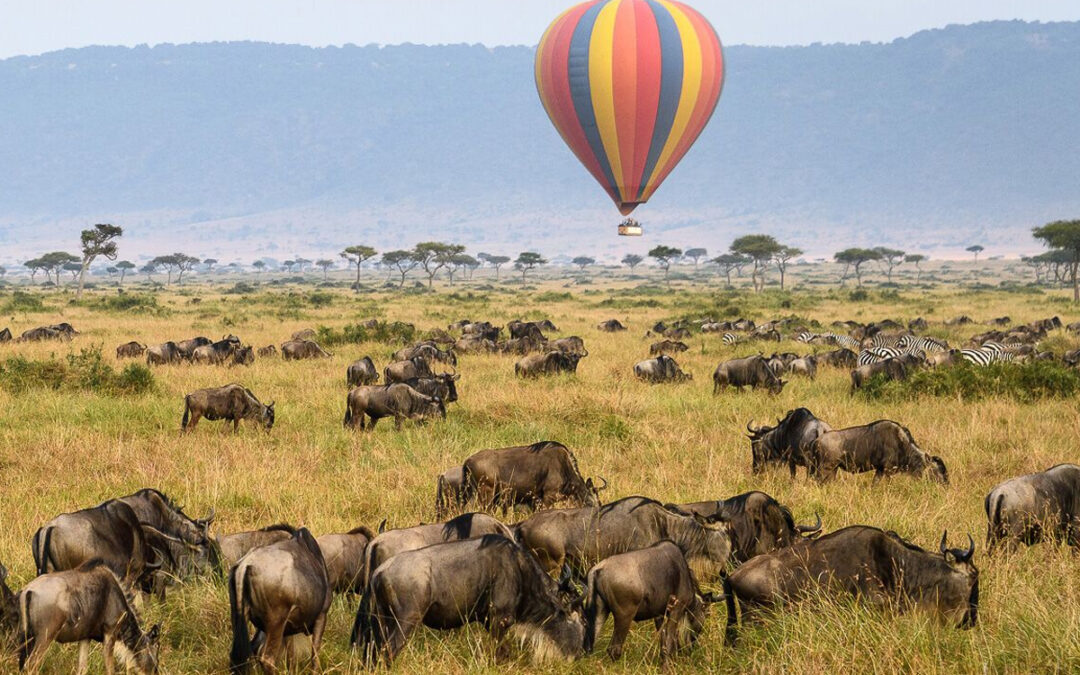Tanzania is renowned for its world-class safari experiences, making it the ideal destination for first-time travelers seeking adventure and close encounters with Africa’s legendary wildlife. From the vast plains of the Serengeti to the remote wilderness of Selous Game Reserve, each safari destination in Tanzania offers something unique and unforgettable. In this article, we’ll take an in-depth look at the top five safari destinations in Tanzania that you can’t afford to miss.
Serengeti National Park
No safari in Tanzania would be complete without visiting the legendary Serengeti National Park. Covering over 14,000 square kilometers, the Serengeti is famed for hosting the Great Migration, where over two million wildebeest, zebras, and gazelles journey across the plains in search of greener pastures. This annual event is a wildlife spectacle like no other, attracting predators such as lions, leopards, and cheetahs that stalk the migrating herds.
The Serengeti is a haven for wildlife enthusiasts and photographers alike. Visitors can witness countless species in their natural habitat, from the elusive leopard hiding in a tree to herds of elephants roaming the open plains. First-time safari-goers can also experience the thrill of seeing the Big Five, which includes lions, elephants, leopards, buffalo, and rhinos. While the Great Migration is the Serengeti’s crowning jewel, the park offers incredible wildlife viewing year-round.
For a more intimate experience, hot air balloon safaris provide a bird’s-eye view of the Serengeti, allowing travelers to witness the vast herds below and the breathtaking landscape that stretches to the horizon.
Best time to visit: For the Great Migration, the best times are June to July for river crossings, and December to January for the calving season.
Ngorongoro Crater
Located just west of Arusha, the Ngorongoro Crater is a must-see destination for any first-time traveler to Tanzania. As the world’s largest unbroken volcanic caldera, this natural wonder spans 260 square kilometers and is home to a dense concentration of wildlife. The crater’s enclosed environment makes it a haven for the Big Five, including one of Tanzania’s largest populations of black rhinos, which are critically endangered.
The unique layout of the Ngorongoro Crater makes it one of the best places in Tanzania for a day-long safari. Visitors can descend into the crater and explore its various ecosystems, from open grasslands to dense forests and freshwater lakes. This biodiversity attracts a wide variety of animals, including lions, elephants, buffalo, hippos, and over 400 species of birds.
The crater also holds significant cultural value, as the surrounding Ngorongoro Conservation Area is home to the semi-nomadic Maasai people, who live harmoniously with the wildlife. Visitors can often see Maasai herders guiding their cattle along the crater rim.
Best time to visit: The dry season, from June to October, is the best time for wildlife viewing, as animals tend to congregate around water sources within the crater.
Tarangire National Park
For travelers looking for a less crowded and more peaceful safari experience, Tarangire National Park is an excellent choice. This park is often overlooked in favor of the Serengeti and Ngorongoro, but it boasts some of the most spectacular wildlife sightings in Tanzania. One of the park’s key attractions is its large herds of elephants, which can often be seen roaming the park’s landscape, especially during the dry season when they gather around the Tarangire River.
Tarangire is also known for its towering baobab trees, which dot the savannah and create a surreal backdrop for wildlife viewing. The park’s varied terrain includes swamps, rivers, and acacia woodlands, which support a rich diversity of wildlife. In addition to elephants, visitors can spot lions, leopards, cheetahs, and a variety of antelopes.
For bird enthusiasts, Tarangire is a paradise, with over 500 bird species recorded, including the colorful yellow-collared lovebird and the unique Kori bustard. The park’s quieter atmosphere compared to more popular destinations allows travelers to enjoy a more intimate and unhurried safari.
Best time to visit: June to October is the ideal time to visit Tarangire, as the dry season draws large numbers of animals to the river, making wildlife easier to spot.
Lake Manyara National Park
Lake Manyara National Park may be one of Tanzania’s smaller parks, but it is packed with wildlife and offers some of the most stunning scenery in the country. The park is famous for its rare tree-climbing lions, a phenomenon observed in only a few places in Africa. Seeing lions lounging on tree branches is a unique experience that draws wildlife enthusiasts to this beautiful park.
Another highlight of Lake Manyara is the vast flamingo population that flocks to the alkaline lake, creating a mesmerizing pink glow across the water. The park is also home to a wide variety of animals, including elephants, hippos, giraffes, and zebras, all of which can be seen against the backdrop of the Rift Valley escarpment.
While the wildlife is certainly a draw, the scenic beauty of Lake Manyara is equally captivating. The park’s diverse landscape ranges from dense forests to grassy floodplains, making it a perfect location for photography and nature walks.
Best time to visit: The dry season from July to October is ideal for general wildlife viewing, while the rainy season from November to June offers excellent birdwatching opportunities, especially for flamingos.
Selous Game Reserve (Nyerere National Park)
For travelers seeking a more remote and off-the-beaten-path experience, Selous Game Reserve, now known as Nyerere National Park, offers an untouched wilderness that few other parks can match. Covering over 50,000 square kilometers, Selous is one of Africa’s largest game reserves and is home to a diverse array of wildlife, including African wild dogs, lions, elephants, hippos, and crocodiles.
What sets Selous apart from other parks is the opportunity to embark on boat safaris along the Rufiji River. This unique safari experience allows visitors to see animals like hippos, crocodiles, and water birds from a different perspective. The park also offers walking safaris, where travelers can explore the bush on foot with a trained guide, providing an up-close look at Tanzania’s flora and fauna.
Due to its remote location, Selous is less visited than other parks, ensuring a peaceful and uncrowded safari. It’s an ideal destination for those looking to immerse themselves in nature and experience Tanzania’s wild side.
Best time to visit: The dry season from June to October is the best time to visit Selous, as wildlife gathers around water sources, making animals easier to spot.
Tanzania is a safari lover’s dream, offering a range of incredible wildlife experiences for first-time travelers. From the iconic Great Migration in the Serengeti to the tranquil beauty of Lake Manyara and the remote wilderness of Selous, Tanzania’s national parks and game reserves provide unforgettable adventures. Each destination offers something unique, making it possible for travelers to tailor their safari experience to their interests and preferences.
When planning your first safari, consider the best times to visit, the type of wildlife you want to see, and the kind of safari experience you’re looking for. Whether you prefer the drama of a river crossing in the Serengeti or the serene landscapes of Tarangire, Tanzania’s safaris are sure to leave you with memories that last a lifetime.
FAQ:
- When is the best time to visit Tanzania for a safari? The best time for a Tanzania safari is during the dry season, from June to October, when wildlife congregates around water sources.
- Which park is best for seeing the Big Five? Both the Serengeti and Ngorongoro Crater are excellent choices for spotting the Big Five, particularly lions, elephants, and rhinos.
- What is unique about Tarangire National Park? Tarangire is known for its large elephant herds and iconic baobab trees, offering a more intimate and less crowded safari experience.
- Can I see the Great Migration year-round? While the Great Migration occurs year-round, the best times to witness key events like river crossings are from June to July, and for the calving season, from December to January.
- Is Selous Game Reserve suitable for first-time travelers? Yes, Selous (Nyerere National Park) offers a more remote and peaceful experience, ideal for those seeking a less commercialized safari.


